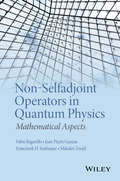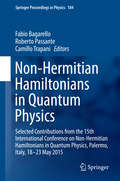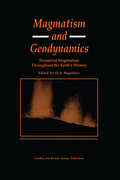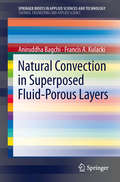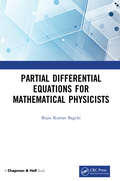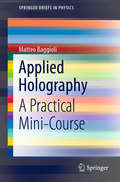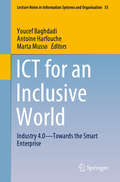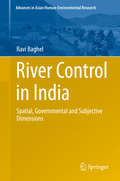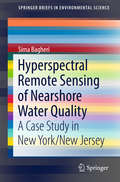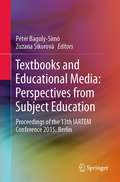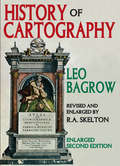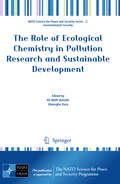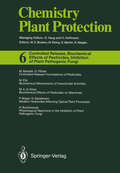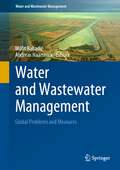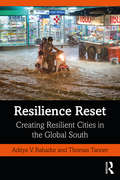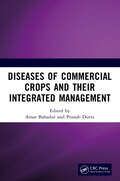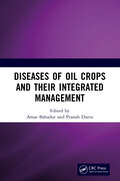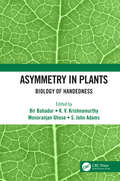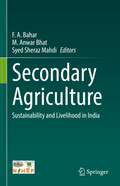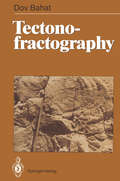- Table View
- List View
Non-Selfadjoint Operators in Quantum Physics: Mathematical Aspects
by Fabio Bagarello Jean-Pierre Gazeau Franciszek Hugon Szafraniec Miloslav ZnojilA unique discussion of mathematical methods with applications to quantum mechanics Non-Selfadjoint Operators in Quantum Physics: Mathematical Aspects presents various mathematical constructions influenced by quantum mechanics and emphasizes the spectral theory of non-adjoint operators. Featuring coverage of functional analysis and algebraic methods in contemporary quantum physics, the book discusses the recent emergence of unboundedness of metric operators, which is a serious issue in the study of parity-time-symmetric quantum mechanics. The book also answers mathematical questions that are currently the subject of rigorous analysis with potentially significant physical consequences. In addition to prompting a discussion on the role of mathematical methods in the contemporary development of quantum physics, the book features: Chapter contributions written by well-known mathematical physicists who clarify numerous misunderstandings and misnomers while shedding light on new approaches in this growing area An overview of recent inventions and advances in understanding functional analytic and algebraic methods for non-selfadjoint operators as well as the use of Krein space theory and perturbation theory Rigorous support of the progress in theoretical physics of non-Hermitian systems in addition to mathematically justified applications in various domains of physics such as nuclear and particle physics and condensed matter physics An ideal reference, Non-Selfadjoint Operators in Quantum Physics: Mathematical Aspects is useful for researchers, professionals, and academics in applied mathematics and theoretical and/or applied physics who would like to expand their knowledge of classical applications of quantum tools to address problems in their research. Also a useful resource for recent and related trends, the book is appropriate as a graduate-level and/or PhD-level text for courses on quantum mechanics and mathematical models in physics.
Non-Hermitian Hamiltonians in Quantum Physics: Selected Contributions from the 15th International Conference on Non-Hermitian Hamiltonians in Quantum Physics, Palermo, Italy, 18-23 May 2015 (Springer Proceedings in Physics #184)
by Fabio Bagarello Roberto Passante Camillo TrapaniThis book presents the Proceedings of the 15th International Conference on Non-Hermitian Hamiltonians in Quantum Physics, held in Palermo, Italy, from 18 to 23 May 2015. Non-Hermitian operators, and non-Hermitian Hamiltonians in particular, have recently received considerable attention from both the mathematics and physics communities. There has been a growing interest in non-Hermitian Hamiltonians in quantum physics since the discovery that PT-symmetric Hamiltonians can have a real spectrum and thus a physical relevance. The main subjects considered in this book include: PT-symmetry in quantum physics, PT-optics, Spectral singularities and spectral techniques, Indefinite-metric theories, Open quantum systems, Krein space methods, and Biorthogonal systems and applications. The book also provides a summary of recent advances in pseudo-Hermitian Hamiltonians and PT-symmetric Hamiltonians, as well as their applications in quantum physics and in the theory of open quantum systems.
Magmatism and Geodynamics: Terrestrail Magmatism Throughout the Earth's History
by O. A. BagatikovMagnatism is the only true endogenic process for generating new material on the Earth's surface. Obviously, magmatism and tectonic movements are reflections of geodynamics, that is, physical processes which occur in deep-seated environments. What are the interrelationships between magmatism and tectronics? How did the character of terrestrial magmatism change through time and are there any irregularities in this process?
Natural Convection in Superposed Fluid-Porous Layers (SpringerBriefs in Applied Sciences and Technology)
by Aniruddha Bagchi Francis A. KulackiNatural Convection in Composite Fluid-Porous Domains provides a timely overview of the current state of understanding on the phenomenon of convection in composite fluid-porous layers. Natural convection in horizontal fluid-porous layers has received renewed attention because of engineering problems such as post-accident cooling of nuclear reactors, contaminant transport in groundwater, and convection in fibrous insulation systems. Because applications of the problem span many scientific domains, the book serves as a valuable resource for a wide audience.
Partial Differential Equations for Mathematical Physicists
by Bijan Kumar BagchiPartial Differential Equations for Mathematical Physicists is intended for graduate students, researchers of theoretical physics and applied mathematics, and professionals who want to take a course in partial differential equations. This book offers the essentials of the subject with the prerequisite being only an elementary knowledge of introductory calculus, ordinary differential equations, and certain aspects of classical mechanics. We have stressed more the methodologies of partial differential equations and how they can be implemented as tools for extracting their solutions rather than dwelling on the foundational aspects. After covering some basic material, the book proceeds to focus mostly on the three main types of second order linear equations, namely those belonging to the elliptic, hyperbolic, and parabolic classes. For such equations a detailed treatment is given of the derivation of Green's functions, and of the roles of characteristics and techniques required in handling the solutions with the expected amount of rigor. In this regard we have discussed at length the method of separation variables, application of Green's function technique, and employment of Fourier and Laplace's transforms. Also collected in the appendices are some useful results from the Dirac delta function, Fourier transform, and Laplace transform meant to be used as supplementary materials to the text. A good number of problems is worked out and an equally large number of exercises has been appended at the end of each chapter keeping in mind the needs of the students. It is expected that this book will provide a systematic and unitary coverage of the basics of partial differential equations. Key Features An adequate and substantive exposition of the subject. Covers a wide range of important topics. Maintains mathematical rigor throughout. Organizes materials in a self-contained way with each chapter ending with a summary. Contains a large number of worked out problems.
Partial Differential Equations for Mathematical Physicists
by Bijan Kumar BagchiPartial Differential Equations for Mathematical Physicists is intended for graduate students, researchers of theoretical physics and applied mathematics, and professionals who want to take a course in partial differential equations. This book offers the essentials of the subject with the prerequisite being only an elementary knowledge of introductory calculus, ordinary differential equations, and certain aspects of classical mechanics. We have stressed more the methodologies of partial differential equations and how they can be implemented as tools for extracting their solutions rather than dwelling on the foundational aspects. After covering some basic material, the book proceeds to focus mostly on the three main types of second order linear equations, namely those belonging to the elliptic, hyperbolic, and parabolic classes. For such equations a detailed treatment is given of the derivation of Green's functions, and of the roles of characteristics and techniques required in handling the solutions with the expected amount of rigor. In this regard we have discussed at length the method of separation variables, application of Green's function technique, and employment of Fourier and Laplace's transforms. Also collected in the appendices are some useful results from the Dirac delta function, Fourier transform, and Laplace transform meant to be used as supplementary materials to the text. A good number of problems is worked out and an equally large number of exercises has been appended at the end of each chapter keeping in mind the needs of the students. It is expected that this book will provide a systematic and unitary coverage of the basics of partial differential equations. Key Features An adequate and substantive exposition of the subject. Covers a wide range of important topics. Maintains mathematical rigor throughout. Organizes materials in a self-contained way with each chapter ending with a summary. Contains a large number of worked out problems.
Applied Holography: A Practical Mini-Course (SpringerBriefs in Physics)
by Matteo BaggioliThis primer is a collection of notes based on lectures that were originally given at IIT Madras (India) and at IFT Madrid (Spain). It is a concise and pragmatic course on applied holography focusing on the basic analytic and numerical techniques involved. The presented lectures are not intended to provide all the fundamental theoretical background, which can be found in the available literature, but they concentrate on concrete applications of AdS/CFT to hydrodynamics, quantum chromodynamics and condensed matter. The idea is to accompany the reader step by step through the various benchmark examples with a classmate attitude, providing details for the computations and open-source numerical codes in Mathematica, and sharing simple tricks and warnings collected during the author’s research experience. At the end of this path, the reader will be in possess of all the fundamental skills and tools to learn by him/herself more advanced techniques and to produce independent and novel research in the field.
ICT for an Inclusive World: Industry 4.0–Towards the Smart Enterprise (Lecture Notes in Information Systems and Organisation #35)
by Youcef Baghdadi Antoine Harfouche Marta MussoThis book discusses the impact of information and communication technologies (ICTs) on organizations and on society as a whole. Specifically, it examines how such technologies improve our life and work, making them more inclusive through smart enterprises. The book focuses on how actors understand Industry 4.0 as well as the potential of ICTs to support organizational and societal activities, and how they adopt and adapt these technologies to achieve their goals. Gathering papers from various areas of organizational strategy, such as new business models, competitive strategies and knowledge management, the book covers a number of topics, including how innovative technologies improve the life of the individuals, organizations, and societies; how social media can drive fundamental business changes, as their innovative nature allows for interactive communication between customers and businesses; and how developing countries can use these technologies in an innovative way. It also explores the impact of organizations on society through sustainable development and social responsibility, and how ICTs use social media networks in the process of value co-creation, addressing these issues from both private and public sector perspectives and on national and international levels, mainly in the context of technology innovations.
River Control in India: Spatial, Governmental and Subjective Dimensions (Advances in Asian Human-Environmental Research)
by Ravi BaghelLarge river systems throughout the planet have been dramatically transformed due to river control projects such as large dams and embankments. Unlike other major human impacts like anthropogenic climate change, the alteration of river systems has been deliberate and planned by a small, powerful set of experts. Taking India as a case study, this book examines the way experts transform the planet through their discourse by their advocacy of river projects. This book identifies the spatial aspects of the norms through which the ideal river and the deficient river in need of control are produced. The role of governmental rationality in explaining the seemingly irrational and counter-productive effects of large projects like Kosi river embankments is considered. Finally using autobiographical material, the subjectivity of expert advice is examined, questioning its presumed objectivity. By examining the different subjective stances arising from the same body of expertise, this book discusses the consequences this has for river control specifically and for the relation between expertise and environmental change in general.
Hyperspectral Remote Sensing of Nearshore Water Quality: A Case Study in New York/New Jersey (SpringerBriefs in Environmental Science)
by Sima BagheriThis book provides details on of the utility of hyperspectral remote sensing – NASA/AVIRIS in nearshore water quality issues of NY/NJ. It demonstrates the use of bio optical modeling and retrieval techniques to derive the concentrations of important water quality parameters (chlorophyll, color dissolved organic matter and suspended sediments) in the study area. The case study focuses on the nearshore waters of NY/NJ considered as a valued ecological, economic and recreational resource within the New York metropolitan area. During field campaigns (1998-2001) measurements were made to establish hydrological optical properties of the NY/NJ nearshore waters with concurrent NASA/AVIRIS overflights. The field measurements included: 1) concurrent above and below surface spectral reflectance; 2) shipboard sampling for determination of inherent optical properties (IOP); and 3) concentrations of optically important water quality parameters. Understanding the relationship between reflectance, absorption and scattering is essential for developing the analytical algorithm necessary to use remote sensing as a monitoring /management tool in the nearshore environment.
Device Applications of Nonlinear Dynamics (Understanding Complex Systems)
by Salvatore Baglio Adi BulsaraThis book is devoted to applications of complex nonlinear dynamic phenomena to real systems and device applications. In recent decades there has been significant progress in the theory of nonlinear phenomena, but there are comparatively few devices that actually take this rich behavior into account. The text applies and exploits this knowledge to propose devices which operate more efficiently and cheaply, while affording the promise of much better performance.
Textbooks and Educational Media: Proceedings of the 13th IARTEM Conference 2015, Berlin
by Péter Bagoly-Simó Zuzana SikorováThis book brings together empirical research and conceptual work on textbooks and education media from 13 countries and 17 disciplines. Along with textbook production, usage, and development, it also explores the interconnectedness of (educational) policy and teaching and learning materials. Further, the book offers insights into regional and local discourses (e.g. specific theories of Portuguese- and Spanish-speaking countries as well as Nordic countries, contrasting their theories with international literature), practices, and solutions with regard to teaching selected subjects at the pre-primary, primary, secondary, and tertiary level. This book also discusses the specific combinations of subjects (e.g. Physics, Biology, Geography, Swedish, English) and their subject-specific education (e.g. Physics Education or Didactics). Lastly, it examines the work of a number of early-career researchers, giving them a voice and bringing in fresh ideas currently being developed in various countries around the globe.This proceedings volume will appeal to publishers, subject educators in primary, secondary, and tertiary education, and academic researchers from the fields of textbooks, educational media and subject-specific education. Its international authorship and explicit focus on subject-specific particularities of educational media provide a unique and comprehensive overview.
History of Cartography
by Leo BagrowThis illustrated work is intended to acquaint readers with the early maps produced in both Europe and the rest of the world, and to tell us something of their development, their makers and printers, their varieties and characteristics. The authors' chief concern is with the appearance of maps: they exclude any examination of their content, or of scientific methods of mapmaking. This book ends in the second half of the eighteenth century, when craftsmanship was superseded by specialized science and the machine. As a history of the evolution of the early map, it is a stunning work of art and science.This expanded second edition of Bagrow and Skelton's History of Cartography marks the reappearance of this seminal work after a hiatus of nearly a half century. As a reprint project undertaken many years after the book last appeared, finding suitable materials to work from proved to be no easy task. Because of the wealth of monochrome and color plates, the book could only be properly reproduced using the original materials. Ultimately the authors were able to obtain materials from the original printer Scotchprints or contact films made directly from original plates, thus allowing the work to preserve the beauty and clarity of the illustrations.Old maps, collated with other materials, help us to elucidate the course of human history. It was not until the eighteenth century, however, that maps were gradually stripped of their artistic decoration and transformed into plain, specialist sources of information based upon measurement. Maps are objects of historical, artistic, and cultural significance, and thus collecting them seems to need no justification, simply enjoyment.
History of Cartography
by Leo BagrowThis illustrated work is intended to acquaint readers with the early maps produced in both Europe and the rest of the world, and to tell us something of their development, their makers and printers, their varieties and characteristics. The authors' chief concern is with the appearance of maps: they exclude any examination of their content, or of scientific methods of mapmaking. This book ends in the second half of the eighteenth century, when craftsmanship was superseded by specialized science and the machine. As a history of the evolution of the early map, it is a stunning work of art and science.This expanded second edition of Bagrow and Skelton's History of Cartography marks the reappearance of this seminal work after a hiatus of nearly a half century. As a reprint project undertaken many years after the book last appeared, finding suitable materials to work from proved to be no easy task. Because of the wealth of monochrome and color plates, the book could only be properly reproduced using the original materials. Ultimately the authors were able to obtain materials from the original printer Scotchprints or contact films made directly from original plates, thus allowing the work to preserve the beauty and clarity of the illustrations.Old maps, collated with other materials, help us to elucidate the course of human history. It was not until the eighteenth century, however, that maps were gradually stripped of their artistic decoration and transformed into plain, specialist sources of information based upon measurement. Maps are objects of historical, artistic, and cultural significance, and thus collecting them seems to need no justification, simply enjoyment.
The Role of Ecological Chemistry in Pollution Research and Sustainable Development (NATO Science for Peace and Security Series C: Environmental Security)
by Ali Mufit Bahadir Gheorghe DucaSustainable Development has become the leading concept of the 21 century. It describes a development, which agrees with the needs of the present generation but does not endanger the chances of the coming generations to satisfy also their needs. “Sustainable development” has become an important general goal for all fields of life like economy, ecology and social balance. The development and shaping of our future has been discussed internationally like on the summits of the Conferences in Rio and in Johannesburg. But this is also a topic on national base in various countries. Leading authorities in various fields of economy and politics have also accepted this concept. Although the concept of sustainable development has been generally accepted, there are still problems how to achieve and evaluate these general goals. It is clear that the definitions about the prime needs vary from man to man, from country to country and from continent to continent. But pollution does not respect national borders. Therefore, it is necessary to develop the politics of economy, ecology and social demands by a synergistic way that they are strengthened by each other. If it is not possible to stop tendencies, which threaten the future quality of life, the cost demands of societies will dramatically increase and negative tendencies will become irreversible.
Controlled Release, Biochemical Effects of Pesticides, Inhibition of Plant Pathogenic Fungi (Chemistry of Plant Protection #6)
by Mufit Bahadir Peter Böger Heinrich Buchenauer Morifusa Eto Mohammed A.Q. Khan Gerd Pfister Gerhard SandmannSince the middle of the Sixties, new types of formulation for biologically active com pounds have been developed, which have been introduced into the literature under the term Controlled Release Formulations (CRF). Stimulated by results from former and successful pharmaceutical research, which was engaged in the production of prepa rations with protracted effects (introduction onto the market in the year 1952 of D amphetamine in the form of pellets, coated to varying degrees with fats and waxes) 1), experiments were carried out to transfer the prolongation of effectiveness to pesticidal substances also, by means of a depot formulation. Initial work was concerned with the production of protective coatings for sonar systems in marine ecosystems. By means of antifouling paints or rubber coatings containing tri-n-butyl-tin oxide (TBTO), the growth of marine organisms on sonar domes, buoys and hulls in the water could be effectively prevented 2. 3). Controlled release formUlations of pesticides are defined as depot systems which continuously release their toxic constituents into the environment over a specified period of time (usually months to years) 4). According to this definition, such formu lations can be successfully employed where a chronic exposure to biologically active compounds is required over a longer period. The following hypothetical example is intended to illustrate this 5). In Fig. 1, the duration of activity of a non-persistent pesticide with a loss rate under environmental conditions of t1/2 = 15 days, is graphically illustrated.
Water and Wastewater Management: Global Problems and Measures (Water and Wastewater Management)
by Müfit Bahadir Andreas HaarstrickThis volume addresses the situation of water and wastewater management from a global angle, underpinned by selected case studies. Without doubt, water and wastewater management are among the greatest challenges of our century, and there is also no doubt that the challenges posed by climate change will become even greater. However, most efforts, especially in developing countries but also in the so-called developed countries, have been less than optimal or not optimal at all. In particular, there are still too many people who have to live without clean water and decent sanitation. Today, 2.2 billion people lack access to safely managed drinking water and wastewater, and 4.2 billion people lack safely managed sanitation services. The question, why this is so and why in many cases in developing countries, is discussed in this book among other urgent water and wastewater management issues.The publication of this book is the start of a book series that in more detail critically reviews, discusses, and analyzes the water and wastewater situation and management in different regions and countries worldwide.
Resilience Reset: Creating Resilient Cities in the Global South
by Aditya V. Bahadur Thomas TannerDrawing on evidence from urban resilience initiatives around the globe, the authors make a compelling argument for a "resilience reset", a pause and stocktake that critically examines the concepts, practices and challenges of building resilience, particularly in cities of the Global South. In turn, the book calls for the world’s cities to alter their course and "pivot" towards novel approaches to enhancing resilience. The book presents shifts in ways of acquiring and analysing data, building community resilience, approaching urban planning, engaging with informality, delivering financing, and building the skills of those running cities in a post-COVID world grappling with climate impacts. In Resilience Reset, the authors encourage researchers, policymakers, and practitioners to break out of existing modes of thinking and doing that may no longer be relevant for our rapidly urbanising and dynamic world. The book draws on the latest academic and practice-based evidence to provide actionable insights for cities that will enable them to deal with multiple interacting shocks and stresses. The book will be an indispensable resource to those studying urbanisation, development, climate change and risk management as well as for those designing and deploying operational initiatives to enhance urban resilience in businesses, international organisations, civil society organisations and governments. It is a must-read for anyone interested in managing the risks of climate impacts in urban centres in the Global South.
Resilience Reset: Creating Resilient Cities in the Global South
by Aditya V. Bahadur Thomas TannerDrawing on evidence from urban resilience initiatives around the globe, the authors make a compelling argument for a "resilience reset", a pause and stocktake that critically examines the concepts, practices and challenges of building resilience, particularly in cities of the Global South. In turn, the book calls for the world’s cities to alter their course and "pivot" towards novel approaches to enhancing resilience. The book presents shifts in ways of acquiring and analysing data, building community resilience, approaching urban planning, engaging with informality, delivering financing, and building the skills of those running cities in a post-COVID world grappling with climate impacts. In Resilience Reset, the authors encourage researchers, policymakers, and practitioners to break out of existing modes of thinking and doing that may no longer be relevant for our rapidly urbanising and dynamic world. The book draws on the latest academic and practice-based evidence to provide actionable insights for cities that will enable them to deal with multiple interacting shocks and stresses. The book will be an indispensable resource to those studying urbanisation, development, climate change and risk management as well as for those designing and deploying operational initiatives to enhance urban resilience in businesses, international organisations, civil society organisations and governments. It is a must-read for anyone interested in managing the risks of climate impacts in urban centres in the Global South.
Diseases of Commercial Crops and Their Integrated Management
by Amar Bahadur Pranab DuttaThis volume compiles information on different aspects of diseases of commercial crops and their management. It contains 17 chapters based on different crops contributed by various authors. The book will be helpful for the students pursuing their degree in Agricultural Sciences, growers, teachers, extension personnel, and fellow researchers in their respective fields.
Diseases of Oil Crops and Their Integrated Management
by Amar Bahadur Pranab DuttaThis volume compiles information on different aspects of diseases of oil crops and their management. It contains 11 chapters based on different crops contributed by various authors. The book will be helpful for the students pursuing their degree in Agricultural Sciences, growers, teachers, extension personnel, and fellow researchers in their respective fields.
Asymmetry in Plants: Biology of Handedness
by Bir Bahadur K. V. Krishnamurthy Manoranjan Ghose S. John AdamsPlants exhibit forms of asymmetry analogous to "handedness" in bilaterally symmetrical animals. This book explores the evolutionary significance and development of asymmetry. Examples of genetic control include the direction of tendril or stem coiling of many climbing plants; the so-called spiral phyllotaxy and floral taxy; and contorted petal arrangement is another kind of left- right symmetry in plants; the direction of contortion is fixed in some but not in other plants. The book will underscore tha all phenomena related to handedness start during embryogenesis itself, with the occurrence of embryo rotation. Key selling features: First consolidated book on Plant Handedness Relates handedness, asymmetry and chirality to the evolution of different organizational levels in plant biology Emphasizes handedness as a vital governing force in plant functional evolution Provides a new perspective, hitherto ignored, into plant developemtn and evolution Describes how an age-old phenomenon can give scope for investigation from a very modern interdisciplinary approach
Asymmetry in Plants: Biology of Handedness
by Bir Bahadur K. V. Krishnamurthy Monoranjan Ghose S. John AdamsPlants exhibit forms of asymmetry analogous to "handedness" in bilaterally symmetrical animals. This book explores the evolutionary significance and development of asymmetry. Examples of genetic control include the direction of tendril or stem coiling of many climbing plants; the so-called spiral phyllotaxy and floral taxy; and contorted petal arrangement is another kind of left- right symmetry in plants; the direction of contortion is fixed in some but not in other plants. The book will underscore tha all phenomena related to handedness start during embryogenesis itself, with the occurrence of embryo rotation. Key selling features: First consolidated book on Plant Handedness Relates handedness, asymmetry and chirality to the evolution of different organizational levels in plant biology Emphasizes handedness as a vital governing force in plant functional evolution Provides a new perspective, hitherto ignored, into plant developemtn and evolution Describes how an age-old phenomenon can give scope for investigation from a very modern interdisciplinary approach
Secondary Agriculture: Sustainability and Livelihood in India
by F. A. Bahar M. Anwar Bhat Syed Sheraz MahdiThis book on ‘Secondary Agriculture’ discusses the goal of doubling farmers’ incomes. The term ‘secondary’ has a bearing on climate change adaptation and its mitigation, small farm viability and profitability, food security, nutrition, sustainable utilization of natural resources, and optimal usage of produce from primary agriculture and farm incomes. Promoting secondary agriculture has implications on attaining sustainable development goals, which aim to connect primary, secondary and tertiary sectors by using slack/idle factors of production, such as land and labour, contributing to primary agriculture production, capturing ‘value’ in primary agricultural activities, and generating additional income at the enterprise level. In context to same, the chapters of this book have been designed to promote secondary agriculture through low-cost skills and technology applications in agriculture and by upscaling knowledge via integrating primary, secondary and tertiary sectors of agriculture. The motivation behind this book is to address the challenges of biotic and abiotic stresses facing the farming community; to increase farmers income through low-cost skills and technology applications in agriculture; to upscale knowledge by integrating primary, secondary and tertiary sectors of agriculture. The food processing sector in India is still in a nascent stage with only 8 per cent of the produce being processed as against 80-98 per cent in case of high-income countries (Government of India, 2008, 2010). The food processing sector is now receiving the boost with the annual growth of 13.2 per cent in registered food processing units during 2004-10 (Government of India, 2011). Against this backdrop, there is a strong need to strategically handle the situation in order to facilitate a self-sustainable and long-run growth of the sector, which is felt possible by focusing on Secondary Agriculture. Though not a panacea for all ailments of the primary sector, but it can definitely drive the growth.
Tectonofractography
by Dov Bahat" ... he who repeats a thing in the name of him who said it brings deliverance to the world ... " Mishnah, Sayings of the Fathers 6; 6 Main Objectives The present book intends to fulfill a number of purposes, which are arranged under the following scheme: 1. A topical review of main subjects in fractography, that branch of science which analyses fracture surface morphology and related features and their causes and mechanisms in technological materials. Among the materials that bear significant affinities to rock are in organic glass, ceramics, metals and polymer glass. 2. A historical review of the main studies published to date on rock fractography. In both these fields of review, one is confronted by the similarities between small-scale (micro metre) and large-scale (tens of metres) fracture surface morphologies. The similarities, on the one hand, and the differences on the other must surely promote further development of fractographical approaches in structural geology, where extrapola tion from microfractography to large-scale fractography is virtually a directive. As geologists become more familiar with the fractography of rocks, they undoubtedly will become aware of the great power of this descriptive discipline as a tool, in both qualitative and quantitative analysis. Rock fractography must yet be routinely applied in the structural analysis of rock formations in which fracture morphology is sufficiently prominent or extensive.
